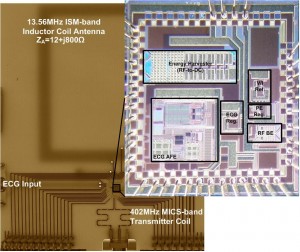During the design process of a wireless system, the antenna and electronic circuit designers sometimes are operating independently from each other and considered to belong to separate disciplines. Both designers agree upon a common characteristic impedance (Z0) of the antenna electronics interface and subsequently optimize their part of the system. The electronic circuit often requires an impedance transformation network while the antenna usually is directly matched to the characteristic impedance of a transmission line to avoid propagation effects in the interface. Traditionally, this characteristic impedance is commonly assumed to be 50 Ω, without any further discussion. Although this standardization may be convenient from a measurement point of view, it is a rather uncomfortable assumption to make as it clearly cannot be the optimum impedance for all design challenges when for example considering noise performance, efficiency or antenna size.
By co-designing the antenna-electronics interface, both disciplines share a common optimization target and can agree on an alternative interface impedance to optimize the overall system performance for a specific application. The choice of interface impedance plays a crucial role in the optimization of antenna systems in the receiving mode, which is the topic addressed in this brief.
Read more in this paper by Mark Stoopman and Yao Liu here.

